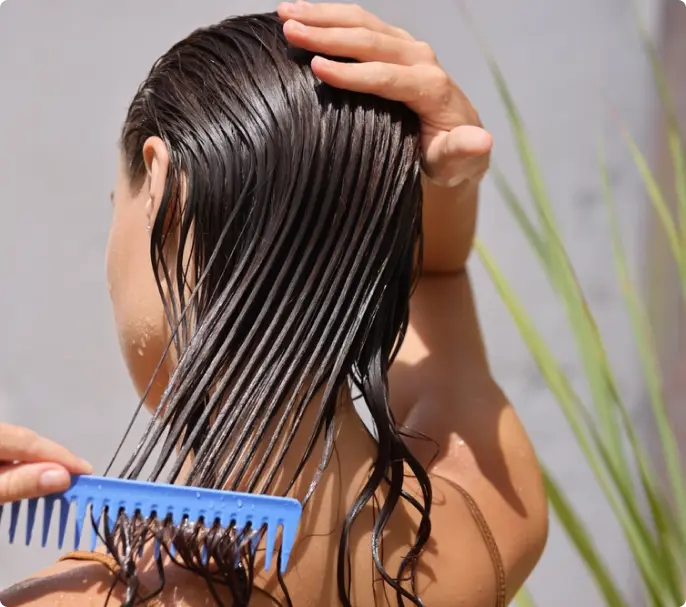
All About Hair
Discover interesting facts about human hair and what is necessary for healthy hair growth.
Get In Touch
Structure Of Healthy Hair

The hair is a flexible, about 0.1 mm thin horn thread of great strength and elasticity. It is formed in the hair bulb
Hair Shaft
Is the part of the hair that is visible from the outside, i.e. what we generally call „hair“. The structural structure of the hair shaft remains stable.
Sebaceous Gland
Supplies the hair shaft with sebum and thus gives the hair its healthy shine.
Hair Follicle
Is a tubular bulge of the skin, the place where the hair is formed.
Hair Bulb
Is the lowest part of the hair follicle. There the hair is created by the formation of new cells. The hair is pressed upwards out of the skin piece by piece – it grows.
Nutrients
That are important for hair growth reach the hair bulb directly through the blood vessels.
Hair Growth Phases
Human hair growth is a dynamic process that is subject to
certain growth cycles and repeats itself regularly.
A hair is not a lifelong companion: it only remains on your
head for about two to six years. During this time, it goes
through various phases:
Get In Touch
1. Anagen phase (growth phase)
The growth or anagen phase lasts between two and six years. A hair grows about 1cm per month in this phase. On average, about 80 to 90% of all hair is currently in this phase.
2. Catagen phase (transitional phase)
After the hair growth period, the hair is separated from the hair root and gradually pushed in the direction of the scalp. This phase (also called catagen phase) lasts up to two weeks and concerns about 1% of all hair on the head.
3. Telogen phase (resting phase)
Now the hair is completely separated from the root and thus also from the nutrient supply. During this phase it can take three to four months for the hair to fall out. Then, the hair follicle, which has pushed the old hair upwards to the scalp, moves back into the deeper layers of the skin. The metabolic process starts again from the beginning and the hair bulb produces cells again: a new hair grows. About 10 to 30% of the hair is currently in this stage.

Interesting Facts About Hair
- Number of hairs on the head: approx. 100,000
- Monthly hair growth: 1 cm
- Total daily hair production: 30 m
- Lifespan of hair: 2-6 years
- Hair loss every day: 80-100
Did You Know That
- Men’s hair grows faster than women’s hair.
- Hair grows faster in warm weather.
- Hair growth slows down with age.
- Cutting or shaving does not affect hair growth.
- Men’s hair is thicker than women’s hair.
- The hair colour and the number of hairs decrease with age.
For healthy hair growth, the hair roots must be supplied with the nutrients they need. A sufficient supply to the organism should be ensured so that problems such as hair loss do not occur.

Nutritional Supply
Nutritional supply: crucial for strong, healthy hair
The nutrients that are important for hair growth reach the hair bulb directly through the bloodstream. If the nutrient supply is not balanced, this leads to a lack of nourishment for the hair bulb. The newly produced hair cells then show deficiencies that become visible on the head: fine or rough, dull hair that no longer shines and is excessively vulnerable.
A balanced supply of B vitamins and amino acids to the hair bulbs is important for hair growth and promotes the formation of strong, healthy hair. Pantogar® capsules contain the B vitamins and amino acids containing Sulphur that hair needs for healthy growth.
Get In Touch
Hair and Nails
Just like our hair, well-groomed hands and fingernails contribute a lot of positive things to our appearance. Our own hands are the parts of our bodies we see most often every day.
Our hair and fingernails also reflect our health – and often have the same cause for problems we can see and feel. This is because nail growth and hair growth occur under similar conditions.
A healthy diet and the right behaviour will help you to keep your fingernails from becoming brittle, soft and damaged.
Find out more about brittle fingernails below

Fingernail growth How Do I Treat My Hair Loss?
We would like to inform you about the best known and most common forms of hair loss in men.
Learn the most important facts about the forms and causes of hair loss – as well as about diagnosis and treatment.

Need Help?
Send your inquiry and let’s get in touch with oursupport team
Contact Us
